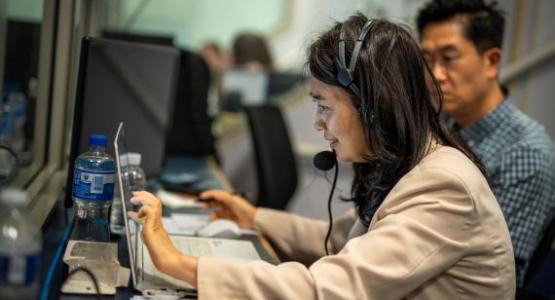
How Translation Professionals Help Spread Hope Worldwide
Story by Jefferson Paradello, Adventist News Network
As a global denomination, the multiple languages represented in the Seventh-day Adventist Church pose a challenge, but also offer a unique opportunity to share the message that Jesus is coming soon.
Part of this process relies on the work of translators who engage with specific content—from publications to sermons—and make it accessible in other languages, thus expanding the reach of the Adventist Church’s vision and mission. That’s exactly what happens during the 62nd General Conference Session.
The Church’s global gathering, which includes 2,809 delegates representing members from more than 200 countries, has a built-in system to provide translation of the meetings into eight languages for those attending in person. These languages are French, Russian, Korean, Portuguese, Spanish, Chinese, Romanian, and German.
Having these languages available at such an event not only facilitates understanding but ensures that the outcomes of the discussions reach local churches. That’s the point emphasized by Pastor César Efren Gonzalez from Cuernavaca, Mexico.
“Not all delegates, myself included, speak English. And by relying on the work of translators, we are able to fulfill the purpose for which we are here. That’s important not just for me, but for the local church, the Conference [regional headquarters], so we can more fully share the content of this entire Session,” he explains.
With 34 years of full-time ministry experience and attending his second General Conference Session, Gonzalez points out that this resource furthers the Church’s mission to ensure “everything we have and everything we are can reach the farthest corners of the world.” He adds: “We need to use every possible means—digital, print, written, television, radio—and flood this world with who we are and what we believe,” he stresses.
A Ministry That Connects People
To make all General Conference Session meetings understandable for delegates, a group of professionals and volunteers work across the three daily meeting blocks, rotating to provide the best possible quality for participants.
In total, 60 individuals make up the translation team for the eight languages, explains Roger Steves, the translation coordinator. His role is to build interpreter teams for Spanish, French, and Portuguese and ensure they have all the tools they need to do their job—scripts, video presentations, and other resources.
The other language groups—Russian, Korean, Chinese, Romanian, and German—bring their own interpreters, and Steves ensures that all teams have equal access to materials and equipment.
“This is truly a ministry. Interpretation isn’t just about translating words; it’s about building bridges. Through real-time interpretation, we ensure that every delegate—regardless of language or cultural background—can fully participate, understand, and contribute,” he explains.
He further emphasizes that this work fosters inclusion, unity, and engagement within a global Church. “At the General Conference Session, where crucial decisions are made that affect millions of members around the world, it is vital that everyone has a voice. Our work makes that possible. In that sense, we’re not just interpreting speeches—we’re helping the global Church family function as one,” he affirms.
Contributing to the Church’s Mission
Tiana Rabearison, originally from Madagascar and now living in Clinton Vicksburg, United States, is participating for the first time on the French interpretation team. She believes this work breaks down barriers in preaching the gospel to every tribe and language. “It’s the fulfillment of the promises of the Holy Spirit,” she notes.
“I’ve always enjoyed interpreting during evangelistic meetings and sermons in my home country. I’ve always been passionate about the ministry of translation and wanted to use my talents for the global mission of the Church,” she says.
Simultaneous interpretation is mentally and physically demanding—far more than the type of translation most people are familiar with, Steves explains. “To help manage the intensity, interpreters are assigned in teams of two, and each team covers a specific time slot: morning, afternoon, or evening. Sometimes, depending on the schedule, an interpreter may work both morning and evening shifts on the same day,” he adds.
Eliud Roman Juarez, an Adventist pastor in Mexico and first-time special guest at the General Conference Session, affirms that the interpreters’ work enables understanding of what’s being discussed so members back home can be informed about how such a session works. It also allows him to explain how delegates from around the world contribute to decision-making processes.
Special Thanks
Roger Steves took time to extend special thanks to individuals who have been instrumental in making this work possible. His full statement is as follows:
“I would like to give special thanks to Karl and Sammy from Adventist World Radio, who manage the technical side of interpretation. If anything goes wrong with the broadcast, they’re the ones who jump in to fix it.
In addition, Luci, my assistant, has been essential in locating scripts and preparing the resources our interpreters need. I also want to recognize Marius Andrei, our only Romanian interpreter for this Session. His incredible dedication—covering morning, afternoon, and evening shifts all by himself—is a true demonstration of the spirit of service that defines this ministry. We are deeply grateful for his commitment.”
Watch the 2025 GC Session live on ANN’s YouTube channel and follow ANN on X for live updates. Join the ANN WhatsApp Channel for the latest Adventist news.

Add new comment